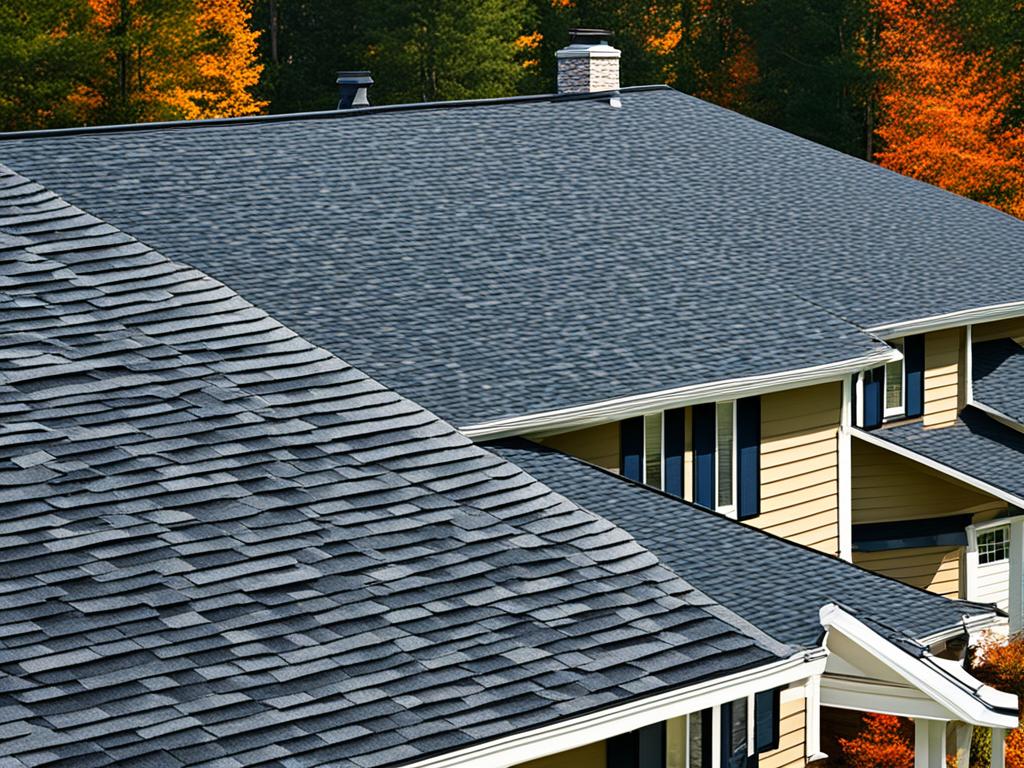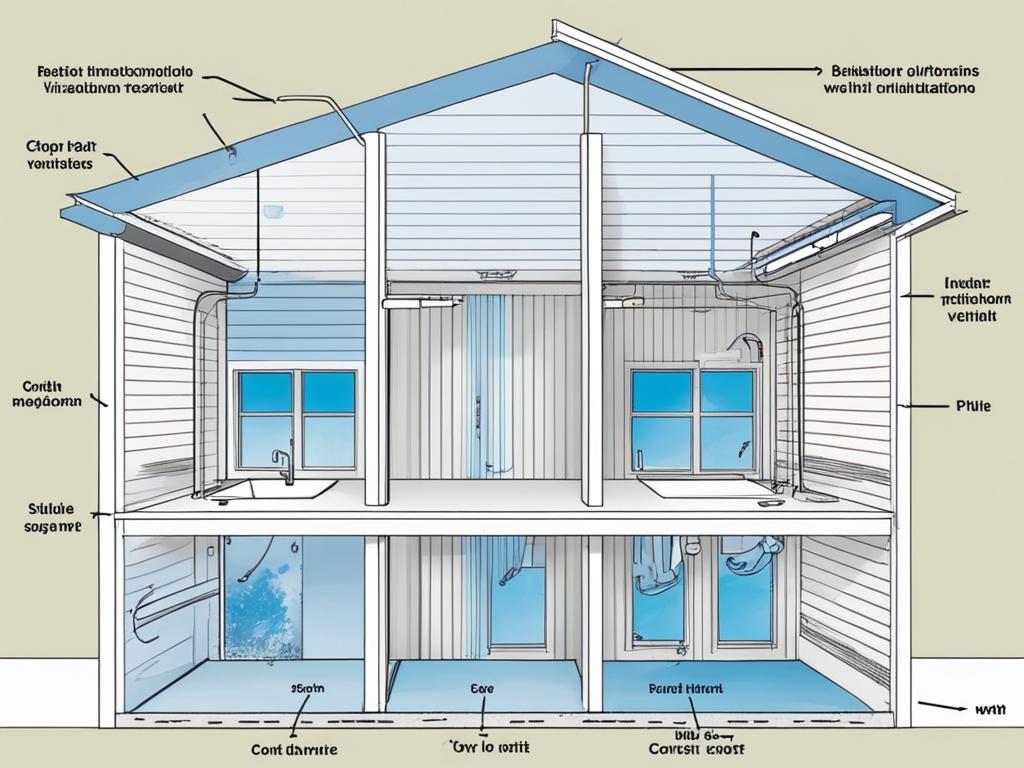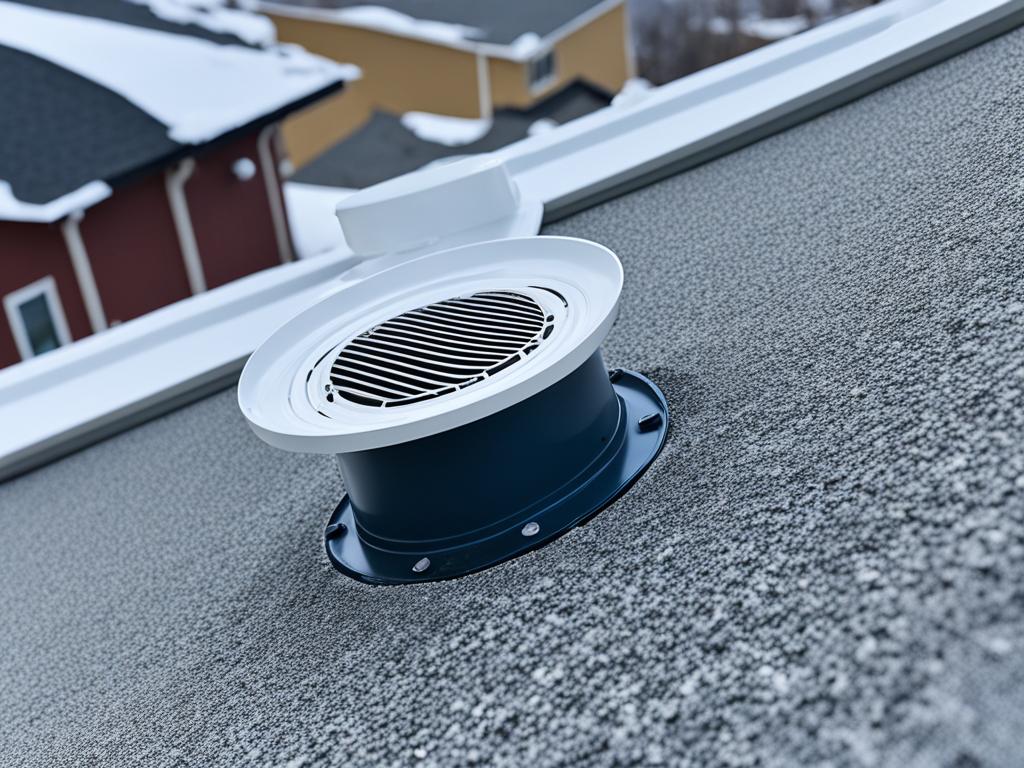When it comes to optimizing the ventilation in your bathroom, choosing the right venting option is crucial. Two popular choices are venting through the soffit or the roof. In this article, we will explore the pros and cons of each option and provide you with a comprehensive guide to selecting the best vent for your bathroom.
Key Takeaways:
- Bathroom venting options: soffit or roof vents
- Consider the pros and cons of each option
- Assess the climate and potential risks
- Evaluate the existing ventilation system in your home
- Consult with professionals for optimal installation
Venting through the Roof: Pros and Cons
Venting a bathroom through the roof is often marketed as the better solution, but it comes with its own set of pros and cons. While it may be easier to install a roof vent, especially for new home construction, it can pose challenges in colder areas that receive heavy snowfall. Snow can bury the vent and cause condensation issues, potentially leading to damage and leaks. Additionally, roof venting may create a cozy entrance for animals and pests, increasing the risk of infestation.

Comparing Roof Vents and Soffit Vents
When comparing vent options for bathrooms, it is important to consider the specific advantages and disadvantages of roof vents and soffit vents. Here is a breakdown:
| Roof Vents | Soffit Vents |
|---|---|
| Easier installation, especially for new home construction | Optimal ventilation in colder climates with heavy snowfall |
| Increased risk of snow burial and condensation issues | May require additional measures to prevent moisture and fumes from being drawn back into the attic |
| Potential entrance for animals and pests | Existing circulation benefits in attics |
Venting through the Soffit: Pros and Cons
Venting a bathroom through the soffit can be a viable option, especially in colder climates with heavy snowfall. This method allows you to fully bury the ductwork in insulation, reducing condensation in the pipe and minimizing the risk of damage. By utilizing the existing soffit vents, which are designed to facilitate circulation through the attic, you can ensure optimal airflow for effective bathroom ventilation.
However, it is crucial to ensure that the soffit vents are properly installed and sealed to prevent any moisture or fumes from being drawn back into the attic. Failure to do so may result in undesirable issues like mold growth or stagnant odors. Consulting with a professional can help ensure that the installation is done correctly, maximizing the benefits of venting through the soffit.
Pros of Venting through the Soffit:
- Burying the ductwork in insulation reduces condensation and potential water damage
- Existing soffit vents aid in optimal attic airflow
Cons of Venting through the Soffit:
- Improper installation or sealing may lead to moisture and fume leakage into the attic
When considering bathroom venting options, it’s crucial to weigh the pros and cons of venting through the soffit against other alternatives like venting through the roof. The right choice depends on various factors such as climate, local regulations, and existing ventilation systems in your home. Prioritize efficient airflow, moisture control, and compliance with building codes to ensure a well-ventilated and comfortable bathroom environment.

| Venting Option | Pros | Cons |
|---|---|---|
| Rooftop Vent | Easier installation, suitable for new construction | Potential snow burial, condensation issues, risk of animal infestation |
| Soffit Vent | Buried ductwork reduces condensation, facilitates optimal airflow | Improper installation can lead to moisture and fume leakage |
Factors to Consider when Choosing a Venting Option
When selecting the right venting option for your bathroom, several factors should be taken into consideration.
- Climate: Assess the climate in your area to determine whether roof venting or soffit venting would be more suitable. Consider the potential risks of condensation, snow accumulation, and animal infestation.
- Existing Ventilation System: Evaluate the current ventilation system in your home and determine if any modifications or improvements are necessary. It is important to ensure that the chosen venting option complements the existing system and enables optimal airflow.
- Compliance with Building Codes: Ensure that the selected venting option complies with local building codes and regulations. This ensures the longevity and safety of the ventilation system.
Choosing the right venting option for your bathroom requires careful consideration of the climate, existing ventilation system, and adherence to building codes.
By analyzing these factors, you can make an informed decision and select the venting option that best suits your needs and requirements.
Pros and Cons of Soffit and Roof Vents
| Vent Option | Pros | Cons |
|---|---|---|
| Soffit Vent |
|
|
| Roof Vent |
|
|

By analyzing the pros and cons of soffit and roof vents, you can make an informed decision based on your specific needs and considerations.
Installation Guide for Bathroom Vent
Installing a bathroom vent requires careful planning and proper execution. Follow this step-by-step guide to optimize bathroom ventilation and ensure a successful installation:
- Choose the right size and capacity for your bathroom. Consider factors such as square footage and the number of fixtures to determine the ventilation needs.
- Determine the best location for the vent. Take into account the desired airflow and moisture control. Optimal placement will vary depending on the layout of your bathroom.
- If opting for a roof vent, it’s crucial to install it with a durable and watertight cap. This will prevent leaks and protect against harsh weather conditions. Make sure the vent is properly sealed to maintain optimal performance.
- For soffit vent installation, ensure that the ductwork is properly insulated and sealed to prevent energy loss and condensation issues. Proper insulation will also help reduce noise transmission.
- Consult with a professional electrician or HVAC specialist for expert advice and guidance throughout the installation process. They can provide valuable insights and ensure that the vent is installed correctly and meets all safety standards.
By following this installation guide, you can optimize bathroom ventilation and create a comfortable and healthy environment in your home.
Conclusion
When it comes to choosing the best ventilation option for your bathroom, considering the climate, potential risks, and existing ventilation system is crucial. While both venting through the soffit and the roof have their advantages and disadvantages, venting through the soffit can be a more suitable choice for colder climates with heavy snowfall.
Venting through the soffit allows for the complete burial of the ductwork in insulation, reducing the risk of condensation in the pipe. Soffit vents are designed to facilitate airflow through the attic, ensuring optimal circulation for efficient bathroom ventilation. However, be sure to properly install and seal the soffit vents to prevent moisture and fumes from being drawn back into the attic.
Ultimately, the best bathroom venting solution depends on your specific needs and requirements. Consult with professionals to ensure proper installation and optimal airflow for your bathroom. By carefully considering your climate, potential risks, and existing ventilation system, you can make an informed decision to achieve the best bathroom ventilation for a comfortable and healthy living environment.
FAQ
What is the best choice for bathroom venting, soffit or roof?
The best choice for bathroom venting depends on factors such as climate, potential risks, and existing ventilation system. Venting through the soffit is a good alternative in colder climates with heavy snowfall, while venting through the roof may be easier for new home construction.
What are the pros and cons of venting through the roof?
Venting through the roof is easier to install for new home construction, but it may pose challenges in colder areas with heavy snowfall. Snow can bury the vent, causing condensation issues and potential damage. Roof venting may also create entry points for animals and pests, increasing the risk of infestation.
What are the pros and cons of venting through the soffit?
Venting through the soffit can be a good alternative, especially in colder climates with heavy snowfall. It allows for burying the ductwork in insulation, reducing condensation. Soffit vents are designed to facilitate circulation through the attic, optimizing airflow for bathroom ventilation. However, proper installation and sealing are important to prevent moisture and fumes from being drawn back into the attic.
What factors should be considered when choosing a venting option?
When choosing a venting option for your bathroom, consider the climate in your area, potential risks of condensation and snow accumulation, and the existing ventilation system. Evaluate the ventilation needs based on factors such as square footage and the number of fixtures. It is also essential to ensure compliance with local building codes and regulations.
How do I install a bathroom vent?
Installing a bathroom vent requires careful planning and proper execution. Start by selecting the right size and capacity for your bathroom. Determine the best location for the vent to ensure optimal airflow and moisture control. For a roof vent, install a durable and watertight cap to prevent leaks. For a soffit vent, ensure proper insulation and sealing of the ductwork. It is recommended to consult with a professional electrician or HVAC specialist for optimal results.
What is the conclusion regarding venting through the soffit or the roof for bathroom?
The choice between venting through the soffit or the roof for your bathroom depends on various factors. While both options have their pros and cons, venting through the soffit can be a better choice in colder climates with heavy snowfall. Ultimately, the best bathroom venting solution will depend on your specific needs and requirements. Consult with professionals to ensure proper installation and optimal airflow.



